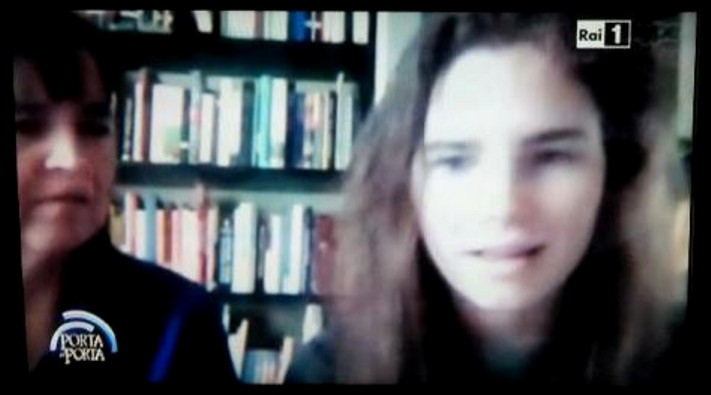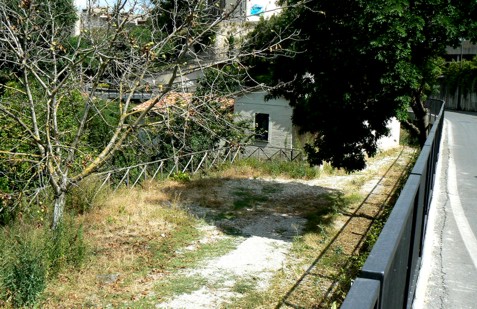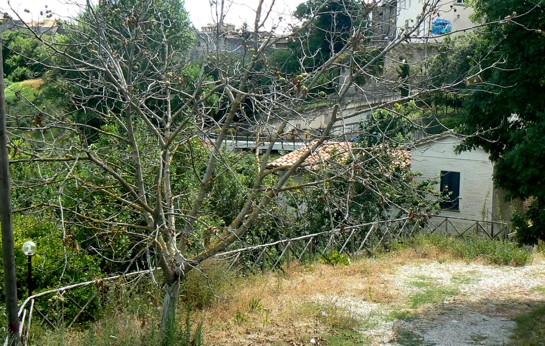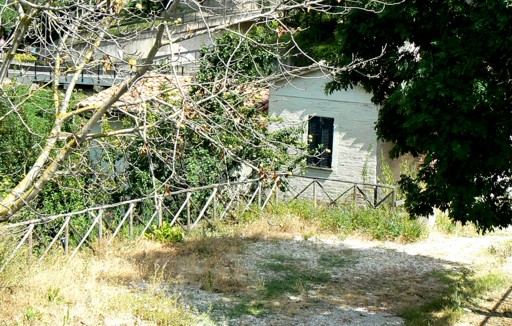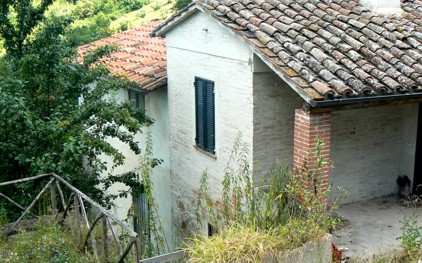
Category: Hoaxes Knox & team
Tuesday, November 05, 2013
RS And AK Seemingly Competing To “Appropriate” Meredith: Ghoulish, Sadistic And Very Cruel? Or…?
Posted by Our Main Posters
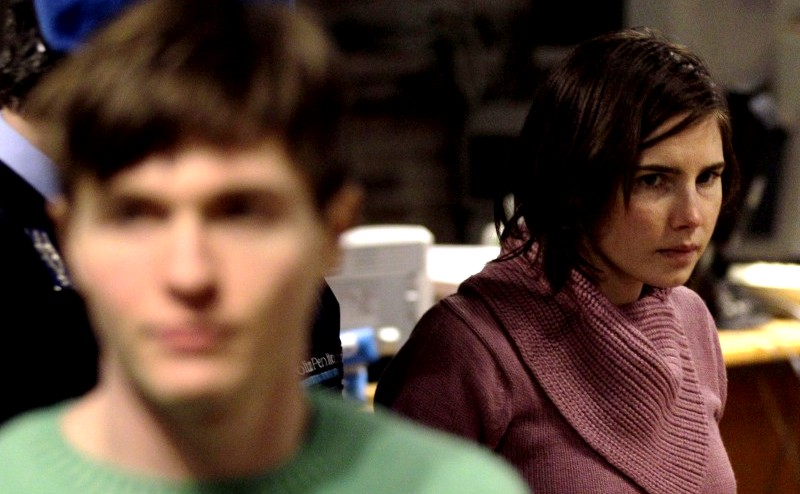
Amanda Knox has stated several times on national TV that she would like to visit Meredith’s grave.
Meredith’s father responded very firmly that this was quite out of the question. The family will never approve. Perhaps predictably, Raffaele Sollecito then announced triumphally that he had already been.
We can be sure that this exchange will do them no good at all in the Florence court, where the prospects of Judge Massei’s special considerations (which lopped five years off their sentences) being re-allowed by the Nencini court now seem pretty dim.
Other than as a ghoulish competition, can this be seen any other way? Last Saturday, Skeptical Bystander, no great lover of the perps, aired the suggestion that we might be seeing a new psychological phase coming into play
Skeptical Bystander
My thinking has evolved somewhat about the report that RS visited Meredith’s grave, as well as about AK’s non-stop chatter about doing so with the Kerchers and her grotesque appropriation of Meredith.
I just caught part of a documentary treatment of the Menendez case, wherein two brothers, Lyle and Eric, killed their parents. Both were sentenced to life in prison. In a probation report, Lyle is quoted as saying he has found peace by visiting his parents’ grave, asking for forgiveness, and understanding that they have forgiven him.
It is entirely possible that both AK and RS want forgiveness from Meredith and from her family. What they don’t seem to realize is that they can’t take shortcuts or be given a free pass. Lyle Menendez got sentenced for his crime and began the process of self-examination that leads to accountability.
We asked two of our posting psychologists if we could indeed be seeing something like this. With their agreement, this is their email exchange, in which they both concede that Skeptical Bystander may have had a point:
Psychologist A:
It is entirely probable they want, indeed crave, ‘forgiveness’. The problem is that dysfunctional or disturbed personalities may be able to be aware of their guilt, but not of their shame.
The guilt would want the forgiveness, but the process that leads to the resolution that is forgiveness will not occur - indeed I believe cannot occur- until the shame is ‘owned’.
Just judging from Raffaele’s and Amanda’s faces alone, I would estimate that Raff is slightly nearer than Amanda in approaching his own shame. Unfortunately I see zero in Amanda, and therein lies the huge problem.
If someone lacks sincerity, someone else or circumstances cannot make them more sincere - what I call authentic. It has to come from self-realization.
That’s my ‘take’!
Psychotherapist B:
At a certain point, this is all just speculation about someone I’ve never met, so it’s hard to say one way or another.
My best guess would be that in this case neither Knox nor Sollecito has shown any public signs of really being able to admit to themselves that they’ve done anything to be sorry for.
For what it’s worth, my overall impression, based on what’s been made public, is that Knox would likely not ever have killed anyone if she hadn’t been high and in an especially reckless period of her life and influenced by meeting Sollecito.
She might have gone on being somewhat impulsive and aggressive without ever actually harming anyone, and with luck she might have outgrown it in a few years. I think the kind of cruelty we’ve seen in this case is driven by unconscious feelings and motives.
Clearly it pains her to be seen as guilty; the idea that anyone can think that about her bothers her a lot. It’s easier for me to picture her wanting a visit to Meredith Kercher’s grave to somehow clear her of all of this upsetting suspicion, than truly wanting Meredith’s forgiveness - more wanting to get rid of shame than to atone for guilt or repair harm, if that makes sense.
When I think of forgiveness, I think of a more mature kind of experience. It takes maturity and integrity to own that you’ve done something harmful, to withstand whatever feelings of shame and guilt the realization brings, and to seek to make actual reparation.
But anyone can feel haunted by having done a bad thing, and want someone to take the haunting away. I’m reminded of Bill in Oliver Twist - after he kills Nancy he feels sorry for himself and overwhelmed by the fear of retribution, but you couldn’t say he’s exactly seeking forgiveness - well, maybe a two-dimensional version of it.
Psychologist A:
Yes, quite right. It is all dreadfully disheartening, and still shockingly cruel.
I agree deeply about the unconsciousness of what is going on. One would expect immature adolescents to be acting a lot from their unconscious, and one of the troubles with the joint denial of events is that they are preventing themselves (and others) from growing or becoming more conscious, but instead ‘freezing’ themselves at that awful time 6 years ago.
You: “He feels sorry for himself and overwhelmed with the fear of retribution, but you couldn’t say he’s exactly seeking forgiveness—well, maybe a two-dimensional version of it. “
I see true forgiveness as a powerful phenomenon which occurs at a crucial stage of a healing process. I think it is something that occurs, that happens to one, is experienced, and is far greater than anyone’s ego.
I would think that someone who had hardly begun, or who had not at all commenced, upon this process would actually have no idea about what forgiveness might actually look or feel like, or be, in fact - let alone how to arrive at it.
Their consequent confusion might then manifest in ,as you say, wanting a two-dimensional version of it, that could be summed up as merely ‘not wanting to be seen as bad’. So perpetuating the ‘good image(s)’ of themselves, which is a gross evasion.
They certainly want not to be hated, as probably anyone does. But it is a huge chasm to actually doing something about that, and learning to behave in a way that people with conscience find acceptable.
Psychotherapist B:
I think you’re absolutely right about forgiveness - thank you for saying it so well.
Sunday, November 03, 2013
Knox Apologists Attempt To Bend Congress; But Nobody Important Turns Up
Posted by Our Main Posters
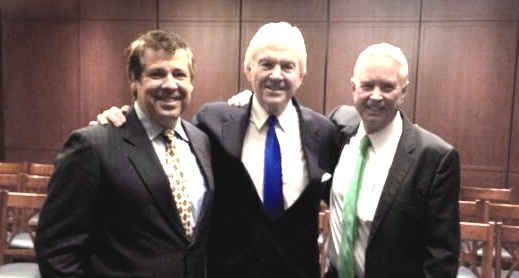
From the left: Steve Moore, John Douglas, and Michael Heavey.
In a room for hire at the Congress they made presentations of their misleading takes on the case to a near-empty room.
Senator Cantwell was apparently there briefly but took off as soon as she could. No other elected leaders were seen to be there.
There was seemingly no media coverage except for a sole post by another Knox apologist on the Infamous Ground Report.
These are hardly the most impartial or for that matter truthful and accurate observers of the case.
Click through for our numerous takedowns of the hapless Steve Moore, and John Douglas, and Michael Heavey.
Sunday, October 20, 2013
Given The Abundant Facts, What Scenario Is The Nencini Court Considering? Probably Not Unlike This
Posted by Marcello

1. The “Innocence/Framing” Campaign
It is rather sad that this case, of the violent murder of Meredith Kercher, has seen a ‘hurricane’ of noise trying to cherry-pick and disprove the more salient facts, and worse, discredit those who investigated, prosecuted and ruled on the case as well as discredit those who continue to emphasize the facts.
Over the past six years there has been a concerted effort by the defendants in this case, and primarily by their families, their “˜groupies’ and their legal consultants, to mount and continue a public relations campaign to frame the defendants as innocent of the crime of murdering Meredith Kercher. This ‘innocence’ campaign has even gone so far as to tarnish the motives of the fine justice officials involved.
The defendants themselves have continuously obfuscated and lied about the more salient facts, albeit inconsistently (their multiple versions fail to match up, and do not match the available facts). Lately Ms. Knox has done a number of (typically unconvincing) interviews, and her parents still seem too intent on defending the fantasy of their daughter’s innocence, all evidence to the contrary.
Mr. Sollecito, for his part, tweets unofficial retractions about statements he made in court. Both have distastefully profited through books that are not much more than a compilation of lies (and which do not offer matching alibis). Meanwhile the legal teams for the defendants have recently leaked “˜favorable’ results from the testing of a new sample on the presumed murder weapon in order to (again) misconstrue the evidence for the general public.
2. Media Misreporting Facilitates
Perhaps the most unfortunate aspect of this “˜innocence campaign’ has been that far too many journalists have dishonored their professional ethics by failing to do the proper research and objectively report the facts. Journalists to this day continue to misreport the facts, leave out corroborating facts, or worse, blindly repeat the distortions or lies promoted by the campaign without proper fact-checking. By and large, journalists (mostly in the US and UK) have ‘anti-reported’ the case.
This is especially grievous given that there are multiple Court Motivations reports (a unique feature to the Italian justice system) readily available in Italian and English online, in searchable PDF format, as well as several websites like this one that have painstakingly sought to illuminate the vast amount of evidentiary facts.
Those journalists who have failed to correctly report the case, and those involved in this ‘innocence’ campaign, have repeatedly disrespected the victim, Meredith Kercher, and her family. By contrast, the Kerchers has shown great dignity throughout these years, remaining patiently quiet and consistently insisting that the truth be revealed by the Italian justice system.
The endless journalistic failures, and particularly the ‘innocence’ campaign, have also disrespected the Italian law enforcement and judicial systems. By contrast Italian law enforcement has demonstrated substantial deference to the defendants, especially when compared to the law enforcement and judicial procedures of other advanced countries. In response, numerous ‘groupies’ have exhibited pathetic jingoism by repeatedly denigrating a country of 60 million people based on rather uninformed attitudes.
And it is very likely that Ms. Knox and Mr. Sollecito, rather than confess the truth, will continue to obfuscate or lie as much as they can, as well as disrespect the Italian Court and the Kerchers by not being present at the appeal. Their ‘innocence’ campaigns will likely continue to distort or ignore the facts. And worse, journalists and talking-head ‘experts’ will continue to report falsehoods and misrepresentations.
3. All Will Now Be To No Avail
Fortunately, none of the fabrications, ill-conceived scenarios or numerous pieces of unprofessional, sloppy journalism will ultimately matter.
This is because the Nencini Appeals Court will not be listening to any of the noise. The Appeals Court has a very specific program to follow, mandated by the Italian Supreme Court, which has already looked at this case four times (the detainment requests for Knox and Sollecito, the conviction of Rudy Guede and the annulment of the Hellmann Appeals Court ruling). The Nencini Appeals Court program includes:
- 1) looking at all the case evidence noted in Judge Massei Trial Court’s Motivations report,
2) considering the Italian Supreme Court’s Motivations report for the conviction of Rudy Guede, in which Guede was convicted of having a role in Ms. Kercher’s murder, but not the key role of fatally stabbing her, and that he acted in concert with others, and
3) considering Ms. Knox’s voluntary “˜gift’ statement of November 6, 2007, in which she placed herself at the scene of the crime. (This statement follows an earlier verbal and written statement released to the police during a few hours of interrogation in the early hours of November 6th.)
4. Big Surfeit Of Evidence
The amount of evidentiary facts the Nencini Appeals Court will have absorbed is substantial. Unlike the Hellmann Appeals Court, they cannot cherry-pick the facts. Per the Supreme Court, they must consider all the available evidence as a whole, logically tied together like a mosaic. Significantly, one could even leave out the knife and bra clasp entirely as evidence points because:
- 1) Ms. Kercher was murdered by more than one assailant. This is evident from the wounds she suffered, from the evidence in general and has been consistently maintained by three different trial judges and four different Supreme Court reports.
2) Guede in all his various confessions has consistently hinted and ultimately confirmed the presence of Knox and Sollecito during the crime.
3) There is no plausible scenario for the crime that involves Guede and two or more unknown assailants.
4) All the other evidence found at the crime scene points to Sollecito and Knox being present before, during and after the crime in some fashion.
5) Knox was at the scene of the crime by her own written admission.
6) The break-in was staged and, by obvious implication, only Knox and Sollecito would have any interest in staging the break-in (see my earlier post listing all the problems with the break-in scenario).
There seems no rational way that the Nencini Appeals Court can logically acquit. And Judge Nencini has not ‘pre-announced’ a non-guilty verdict like Judge Hellmann did by claiming that the defendants “˜appear to be innocent’.
The only remaining questions are what kind of dynamics will the Nencini Appeals Court assign to the participants, and what kind of reasoning will the Italian Supreme Court provide, assuming Knox or Sollecito appeal to the Supreme Court.
Having already read the Massei Motivations report and supporting documentation for weeks, this will already be a highly informed judges’ panel. What scenario are they converging on? The following scenario is based on some of the most significant evidence, and overall seems largely unshakable.
5. Scenario Accounting For The Most Points
The Night Before: Halloween
1) Guede lied about meeting Ms. Kercher on Halloween. (No such meeting was corroborated by witnesses.)
2) Guede lied about his whereabouts in the early evening of November 1, 2007. (His claims of having appointments with friends were not corroborated.)
Evening Prior To Attack
3) Around 8:00 PM on November 1st, Knox left Sollecito’s place to go to work. She received Lumumba’s (her boss) text message around 8:15 PM that she was not needed at work. She responded at 8:35 PM while presumably walking back to Sollecito’s apartment. Then she turned off her phone at 8:35 PM. She was seen at Sollecito’s apartment by 8:40PM.
4) Sollecito received a call from his dad at 8:42 PM. (According to the defendant, they discussed the broken trap in the kitchen sink and how to clean the kitchen floor, and about going to Gubbio with Knox the next day. Significant about this is that the broken trap and clean-up likely happened later. See below.)
5) Sollecito turned off his cellphone at roughly 8:45 PM. (typically, neither Knox or Sollecito turned off their cellphones for the night)
6) Ms. Kercher was last seen by her friend Sophie Purton at roughly 9:00 PM going to her cottage.
7) There was no human interaction with Sollecito’s computer after 9:10 PM.
8) Knox and Sollecito were seen at piazza Grimana, by the cottage, at roughly 9:30 to 10:00 PM, by a homeless man who “˜resided’ at piazza Grimana.
9) Ms. Kercher’s phone made three short calls between 10:00 and 10:15 PM roughly, to check voicemail, a possible attempt to call a bank, and possibly an MMS message.
10) A car broke down near the gate of the cottage at 10:30 PM.
11) Knox and Sollecito were seen at piazza Grimana, by the cottage, at roughly 11:00 PM, again by the same homeless man. He noted they went several times to the railing of the piazza to look down beyond it. (The piazza overlooks the gate of the cottage.)
12) A tow truck came at approximately 11:00 PM to tow the car. The driver of the truck noted a dark-colored car parked in front of the gate of the cottage, which he noted was slightly open. At approximately 11:15 PM the tow truck left and the family in the broken down car departed the area with other friends in a second car. (Sollecito had a dark colored Audi.) No screams were heard and no one noticed Guede, Sollecito or Knox pass through the gate.
13) Sollecito’s dad sent Sollecito an SMS at 11:15PM. The message was not received by Sollecito’s cellphone until roughly 6:00 AM following morning.
The Attack Upon Meredith
14) Knox likely let Sollecito and Guede into the cottage after 11:15 PM, after the tow truck and car had left. Guede went to use the large bathroom and failed to flush his feces. The following is an assumed sequence:
15) Ms. Kercher was restrained in her room and her screams were muffled. (There was bruising on Ms. Kercher’s nose, mouth, lips and chin, suggesting her mouth was covered by one or more persons; only one scream was ever heard from the cottage; Ms. Kercher was familiar with martial arts maneuvers and likely vigorously tried to defend herself)
16) Ms. Kercher was choked and her head likely banged against the wall. (Bruises on Ms. Kercher’s neck suggest she was choked with small hands; Ms. Kercher had bruises to her scalp.)
17) Ms. Kercher’s jeans may have been partially removed to restrain her legs and feet. (There were few bruises to Ms. Kerchers legs and feet, including no signs of ligature. This suggests her legs were immobilized in some other fashion.)
18) Guede held Ms. Kercher’s left wrist, leaving DNA traces on Ms. Kercher’s sweatshirt.
19) Guede likely held Ms. Kercher’s left thigh, brusing it, and left his DNA traces inside her.
20) Ms. Kercher’s sweatshirt was removed and two layers of shirts she had on were rolled up to her neck.
21) Guede left DNA traces on Ms. Kercher’s bra.
22) At least three different types of shoe prints were left on the floor in Ms. Kercher’s room on postcards, papers and the pillowcase. None of these matched Ms. Kercher’s shoes found in her room.
23) A witness heard a man and woman yelling from the direction of the cottage.
24) Ms. Kercher was pricked and stabbed with a small knife in the right side of her neck.
25) Ms. Kercher likely freed her right hand and sustained small cuts. She may have punched Knox in the nose or mouth.
26) Ms. Kercher likely freed her left hand and sustained small cuts. She may have grabbed Knox’s hair, while perhaps ripping off an earring from Knox. (Crime scene photos show blonde hair strands in Ms. Kercher’s left hand)
27) Ms. Kercher was able to scream at the top of her lungs. Two witnesses heard the scream. One witness believed it was around 11:30 PM when she heard it.
28) Ms. Kercher was pricked on her neck and chin with a knife. She was stabbed on the left side of her neck with a large knife. Her neck was roughly 16” off the floor, as suggested by a blood spray pattern on the wardrobe door close to where she was found.
29) A bloody shoeprint fitting Knox’s shoe size was left on the pillowcase. Shoeprints matching Guede’s shoes were also found on the pillowcase.
Right After The Attack
30) Guede may have gone to the bathroom to get two towels to staunch the blood. Guede confessed to this, though no DNA traces of his are found on the towels. Guede’s bloody shoeprints were found around Ms. Kercher’s body, and his bloody hand print was found on the pillow.
31) At this point, Knox may have gone to the small bathroom to check a wound. Knox left traces of her blood mixed with Ms. Kercher’s blood in the bidet, edge of the sink and Q-tip box in the small bathroom. Knox left an additional blood trace on the faucet.
32) Guede handled Ms. Kercher’s purse, leaving DNA traces of himself and Ms. Kercher, likely with Ms. Kercher’s blood. (Traces of Guede’s DNA was found on the zipper of the purse. Because the trace contains blood it was likely left after Ms. Kercher started bleeding.)
33) Guede left bloody shoeprints leading straight down the corridor and out of the cottage.
34) A witness heard someone running on the metal stair of the car park shortly after she heard the scream.
35) The same witness also heard running footsteps on the cottage pebble driveway at roughly the same time.
36) The boyfriend of another witness was bumped into by someone “˜with dark skin’ running up the stone stairs, though the time is unclear.
37) Another witness heard people running in the street that wraps behind the car park.
38) Sollecito likely tossed Ms. Kercher’s cellphones from his car into a nearby garden 1 km away from the cottage at around midnight.
39) Guede was seen at the Domus night club around 2 AM.
Evidence, Manipulated Or Overlooked
Likely sometime later during the night Sollecito and Knox returned to the cottage to eliminate evidence and frame Guede for the crime. In so doing:
40) Sollecito left a partial bloody footprint on the bathmat.
41) Sollecito left his DNA on Ms. Kercher’s bra clasp after removing the bra. (Given blood patterns on the bra, the bra may have been removed after Ms. Kercher had died and certainly after she had been stabbed on the left side)
42) Sollecito left one, possibly two, bloody footprints in the corridor.
43) Knox left two bloody footprints in the corridor. One of these contained her blood as well as Ms. Kercher’s blood. (Knox likely bled during or after the assault and may have stepped in her own blood)
44) Knox left a trace of her blood mixed with Ms. Kercher’s blood on the floor in Romanelli’s room.
45) Knox likely threw Romanelli’s clothes on the floor. She likely used an inordinately large rock to break the window with the outer shutters closed. She likely placed some of the broken glass on the window sill to fake a break-in. (Romanelli and the Postal Police found glass on top of Romanelli’s clothes and laptop, suggesting the room was ransacked and then the window was broken.)
46) Knox, perhaps inadvertently, left a piece of window glass in Ms. Kercher’s room.
47) Knox left a bloody footprint in her room.
48) Knox likely left her only room lamp in Ms. Kercher’s room by accident. (The lamp was found on the floor, by Ms. Kercher’s bed, and it may have been used to exam the bloodied floor around Ms. Kercher’s body to remove evidence, such as perhaps an earring and/or hair.)
49) Knox likely wiped away all her fingerprints throughout the entire house (While a number of fingerprints were found in the cottage and verified belonging to the three other flatmates, no fingerprints were found that could be matched to Knox, not in her room or elsewhere- except for one, on a glass in the kitchen.)
50) Knox and/or Sollecito repositioned Ms. Kercher’s body and covered it with the duvet. (Crime scene photos show from the streaks of blood that Ms. Kercher’s body was moved. There were masses of long hair mixed with blood on the floor, suggesting someone had yanked Ms. Kercher by her hair.)
51) They likely took Ms. Kercher’s wallet, closed her bedroom door and locked it.
Back At Sollecito’s Place
52) Sollecito and Knox returned to Sollecito’s place to clean up. They brought back the large knife and cleaned it with steel wool, and also tried to scrape away build-up/rust by the handle. (The knife was found at Sollecito’s place, with DNA traces of Knox on the handle and by the handle/blade joint, with a DNA trace of Ms. Kercher on the blade, with scratches on the blade and pockets of cleaned stainless steel by the handle.)
53) Sollecito likely disconnected the trap of his kitchen sink, perhaps to clean it. (The trap pipe was found disconnected.)
54) Sollecito and Knox likely used bleach to clean the floor of any blood. (Police observed a strong smell of bleach when entering Sollecito’s apartment.)
55) Sollecito and Knox apparently took a shower. (Knox has recounted a number of “˜ear cleaning’ and ‘shower’ stories.)
56) Sollecito likely put blood stained clothes and shoes into one or more garbage bags and drove in the night to dump them somewhere.
57) Sollecito used his computer at around 5:30 AM and turned on his cellphone at around 6AM.
Events On The Next Morning
58) Knox was seen at a nearby store at around 7:45 AM, just as the store was opening. She was noticed going to the cleaning products section, wearing clothes that were ultimately found on her bed at the cottage.
59) Knox may have traveled back and forth from the cottage with a mop and/or garbage bags. (In her different versions, both verbal and written, she talks about ‘having to fetch a mop from the cottage’.)
60) Knox turned on her cellphone around noon.
The Police At The House
61) Knox and Sollecito were discovered at the cottage by the Postal Police at around 12:30 PM.
62) Knox told the Postal Police that Ms. Kercher sometimes kept her door closed. (This was later contradicted by Romanelli, who insisted Ms. Kercher’s door be broken down.)
63) Knox called her mother in a panic at roughly 12:45 PM. Knox would later forget this phone call in her testimony and in her book.
64) Sollecito called the Carabinieri at around 12:50 PM, confirming nothing was stolen in Romanelli’s room, though he could not have possibly known this for certain.
65) When Ms. Kercher’s door was broken down, at around 1:15 PM, Sollecito and Knox were not with the group that broke the door down, and were not able to see inside the room.
66) Knox panicked when it seemed that Guede’s feces had been flushed by accident.
Later That Same Day
67) At the police station, Knox yelled out that Ms. Kercher “˜bled to death’.
68) At the police station, Knox inveighed against “˜those bastards’ after being fingerprinted, though it’s unclear whether she meant some other killers (and if so, why the plural), or the police.
One Day Later
69) On November 3, 2007, Sollecito lied to a reporter about how the discovery of Ms. Kercher’s body happened, recounting that Knox was the first to discover the body, and that he ‘saw blood everywhere’ even though he could not have seen into the room.
Two Days Later
70) On November 4, 2007, Knox emailed a narrative of the events from her point of view.
71) During the autopsy of November 4th, the prosecutor was convinced by the number and manner of the injuries on Ms. Kercher’s body that there had to be more than one assailant.
72) On November 4, 2007, Knox broke down when police showed her and the other roommates the knives in the silverware drawer at her cottage, to determine if any knives were missing. Knox had to be escorted outside to calm down.
73) Knox would later confess to her parents her concern about the knife at Sollecito’s apartment.
Three Days Later
74) On November 5, 2007, Sollecito failed to back up Knox and changed his alibi when confronted with cellphone records. He maintained Knox left his apartment from roughly 9:00 PM to 1:00 AM.
Four Days Later
75) On November 6, 2007, following Sollecito’s interrogation, Knox blamed Lumumba for the murder, first verbally, then in one written statement, then in a second statement that she offered voluntarily without coercion.
76) Knox failed to make an official retraction of her blaming Lumumba for the murder.
And Subsequentially
77) When first contacted by his friend via Skype, Guede spoke of a man with a knife who was shorter than he, and who had chestnut colored hair (like Sollecito). He also thought Knox was arguing with Ms. Kercher.
78) When Guede was arrested, Sollecito was concerned that Guede might say strange things about him. (If Sollecito was innocent, why be concerned about Guede?)
79) In their multiple “˜confessions’, both Knox and Guede cite Ms. Kercher’s “˜terrible screams’.
80) In court, as a response for finding Ms. Kercher’s DNA on the knife, Sollecito made up a story of pricking Ms. Kercher’s hand while cooking and subsequently apologizing to her about it. But Ms. Kercher had never been to his apartment. Sollecito recently retracted this story on Twitter.
81) Guede eventually confirmed that Sollecito and Knox were with him on the night of the murder.
Some Further Considerations
Ms. Kercher was not promiscuous and had scruples about watering the marijuana plants of the boys residing on the ground floor of the cottage. She had never expressed any interest in Guede to any of her closest friends. Similarly, Guede had never expressed any interest to any of his friends or acquaintances regarding Ms. Kercher.
Some 40+ wounds were found on Ms Kercher’s body. Despite being physically active and knowing martial arts maneuvers, she had few defensive wounds, mostly on the right hand.
She had bruising on her back, her left thigh, lower right leg, both elbows and wrists, the neck, the nose and mouth. She had two significant stab wounds of differing size on opposite sides of the neck, as well as various cuts on face, neck, hands.
No ligature marks were found on her ankles or wrists. She was therefore assaulted by multiple attackers. And as the evidence and trial reports have repeatedly indicated, the attackers were Knox, Sollecito and Guede, with Guede not responsible for the fatal wound.
Thursday, October 17, 2013
When You Get In A Deeeep Hole, Best To Stop Digging: Did Anyone Think To Tell Knox?
Posted by James Higham

[Florence courts in winter; how they might look when the appeal verdict comes down]
Not sure the Knox machine quite understands what trouble their charge is in.
She’s already done three years for calumny and is at it again. Her recent slurs on Italian courts and the police have brought further litigation down on her head.
Then there is the little matter of the court award to Patrick Lumumba for false accusation of murder, which she has not paid to this day, despite earning huge amounts from her fiction work published in America. Every one of us knows what happens when we default.
See how this stands up as her reason not to pay up:
I have already appealed to him to tell him that I didn’t go to the Police Headquarters with the aim of accusing him of a murder he did not commit. What was dragged out of me was dragged out from me without my wanting to harm him.
I only wanted to help and I was completely confused so that I didn’t know what was true and what was not true at that point. Therefore I didn’t want to harm him. I “¦ (MAXI-SIGH) “¦ His.. His name came out only because my mobile phone was there and we exchanged some SMS.
She says: “Vorrei che lui [Patrick]può capire in che situazione io mio trovavo.” I’d like him to understand the situation I’m in. Pardon? A man wrongfully banged-up in prison and owed $80 000 by her should understand the situation she is in?
She was asked what happened and answered, “My best truth is “¦” My best truth? She invented an entire situation with Mignini which simply did not happen according to eyewitnesses, including her translator. Simply did not occur that way. She volunteered a statement but in the light of subsequent events weeks later, changes that, upon advice, to her being browbeaten.
Hence the calumny charges.
Main poster Stilicho adds:
Knox can’t even be honest about her time in prison. She was not in prison because she was wrongly convicted for murder but because of the calunnia she committed against Patrick and as a precaution against her fleeing the country or killing someone else before her trial was completed. She sang and danced and was frequently visited by politicians and other dignitaries. By all accounts, it was the most productive time in her life.
When confronted with her lies, she says, “I was confused.” Sorry ““ courts don’t buy such things. They deal in truth or non-truth. None of this “it seemed to me”. She interprets this real-world reaction as hurtful, hateful to Amanda.
In short, she appears to be emotionally or socially retarded, not fully understanding what she has got herself into. Should she be released on a technicality, as Casey Anthony was, she still faces years inside because of the libel and slander which is piling up. Her own people are also being litigated. Peter Quennell:
We don’t see any sign that David Marriott or Robert Barnett or Ted Simon have the slightest clue about Italian law. They are all liable too for the felonies in the book and all of them could be charged too by the Bergamo judge.
Her advisors need to shut her up before she makes it any worse for herself. In that accusation of Lumumba, she said she was there, in the next room with her hands over her ears because she couldn’t bear Meredith’s screams. It was a clear description, clear enough for the police to arrest Lumumba and put him in prison. The screams coincided with those the neighbours reported.
If one was to substitute Guede and Sollecito, whose bloodied footprint was on the bathmat, for Lumumba, that might be close to the truth of what happened, it would explain no DNA found of hers in the actual room..
Except that there are multiple mixed blood traces and her DNA twice now on the murder weapon, along with her panicked reaction when the cutlery drawer was opened, plus her words to her mother that they’d found a knife and that she was very worried about it. Why would she need to worry if she wasn’t there?
She might be able to explain away the pattern of where her DNA was found on the knife ““ a stabbing grip near the blade ““ as a weird way of cutting vegetables. Then there was Sollecito’s admission over Meredith’s DNA in the scratch as an accident when he pricked Meredith in the hand whilst cooking at his place.
Except Meredith had never been to his place. And he still maintains that Knox was not with him that evening at his own home.
So, despite the sweeping statements by her minders of “no evidence”, which are then syndicated all over the world by their media entourage, inc the Wail, there’s actually copious evidence. After you get past the conflicting stories, the cellphone activity and the witness identifications, there is still the matter of the mixed blood traces.
There was no blood the night before, by Knox’s own admission. Meredith was out that early evening, the two had not been together. These are the sorts of minor anomalies she can only explain with “it seemed to me” or “I imagined”.
Then there is the little matter of the hand marks on the neck, too small for the men although there were other marks too.
The horror for Amanda Knox, in her infantilized state ““ look at her handwriting ““ is that she cannot see consequences, not unlike a child. She doesn’t understand that you can’t go killing someone and get away with it. She’s constantly on about being seen as a good person, as every child and every adult would like and so many of us do not see it that way.
Like a child, she just wants it all to go away and that childlike appearance is what strongly drags in most people’s sympathy ““ here is a State and nasty people worldwide being cruel and mean to a young innocent. Yet she’s getting on for 30 now and is no child. And she still spreads the libel with no thought of consequences, just as she saw no consequences on that night, just the there and then.
The role of drugs cannot be downplayed in this effect on her mind. She’s almost a poster girl for today’s youth and the early sex and drugs, with the dumbing-down at school at the same time.
She’s a mess and it’s hard not to sympathize with that and want help for her “¦ except for one pesky problem. She’s a convicted murderess.
The reaction to these posts will be sympathy for her and anger at the bully who is writing it. It should actually be disgust at what she did and neutrality towards the reporter writing the post. How does it shift from one to the other?
Natural chivalry. Yet in this sympathy for her, there is still the question of her victim choking on her blood once the screams had stopped. And that is what maintains our interest in the case ““ it is unresolved as yet, it is close to the end.
She might get off on a technicality if her lawyers are good enough. She’ll then go into that limbo state of Casey Anthony and all the other broken children of today, the blame for which many of us lay at the door of Them and their narrative.
For sure there is a sadness to it, which a new commenter, David Berlin mentions:
Knox is a hamster on a wheel, in a cage, endlessly condemned to repeating the same nonsense. In an earlier post I saw her as a character in Beckett’s “˜Play’ and the more she opines the more apt that seems. Endlessly repeating a story, fixed in her lines, unable to find an exit.
Commenter Goodlife writes:
Her life now does not seem all that different from her days in prison in that most aspects of her life seem to be under the control of someone else. But does anyone believe that she is any happier or more content now? She is now nothing more than a performing monkey, dishing out the script given to her by her supposed nearest and dearest.
An Italian commented: “Young Italian actors should learn from Amanda Knox. She is a great actress.”
She’d stare at that comment in horror. She uses the term bambina for herself, rather than ragazza, sheltering within this childlike status. At 20. At nearer 30 she is still doing it. She said in an interview that she was la più piccola [the littlest] instead of la più giovane [the youngest]. Littlest evokes more sympathy.
She’s in a prison of her mother’s and her estranged father’s making.
She’s caught up in an international horror story and she’s the leading player. This will always garner sympathy.
She asks why everyone hates her. They don’t hate her ““ that’s child talk. They are appalled by the machine she has behind her and their antics and believe she should take responsibility and start paying off the debt to the dead girl.
Meredith by name.
Wednesday, October 16, 2013
Amanda Knox Risks Penalties For Felony Claims No Different From What Already Cost Her 3 Years
Posted by Peter Quennell
Here is the Amanda Knox Skype interview transcribed for us from the video in Italy. The interviewer is mushy (too much so) and really distorts key facts, and so does Knox. You can see her claim she was framed. Her denials are without substance and seem mechanical and half-hearted. Time for Plan B?
A common question on forums today is “Can Amanda Knox make these very public false charges and suffer no penalty?”
The short answer seems to be no. First, she has made the possibility of early arrest to put a stop to that more likely. If Judge Nencini saw the Porta a Porta TV program last night he will be giving thought to his options. Negotiating on arrest is ruled out by law
And second, for the dozens of false charges in her book and numerous TV and print interviews, she could be facing some more time in prison quite regardless of how the Nencini appeal works out for her. And a guilty verdict there could cost her 30 years and damages.
One thing nobody thought to point out on the rudderless and badly informed Porta a Porta show last night is that Knox is already being investigated for identical false charges.
EVERYTHING she says now is added to that “treasure trove” of actionable accusations. Penalties for these felonies vary; but if one has a prior conviction, some prison time is almost inevitable.
Sorely missing from the Porta a Porta panel last night was their usual magistrate, Simonetta Matone, who has always raised tough questions. Was there a deal not to have her present on what was a distinctly tilted panel?
Knox seems to have committed at least one felony in her book with the pages-long accusation that the investigating prosecutor Dr Mignini was not only present at her interrogation (he wasn’t) but leaning on her to frame Patrick (not being there, of course he didn’t.).
Why didn’t anyone on Porta a Porta introduce that false accusation last night, which was widely reported in the Italian media after her book came out? Or mention her lamp behind Meredith’s door lacking fingerprints, or the mixed-blood traces outside Meredith’s door which seem to strongly relate to what the Carabinieri labs in Rome are now investigating?
Even the defense lawyers are seeing culpability growing, as they are given full credit for helping to write the defamatory books. They all made themselves scarce last night, did anyone notice that?
Do you ever wonder why Knox or Sollecito don’t push their own lawyers forward to take on this challenge?
Below: Pro-prosecution Magistrate Simonetta Matone suspiciously absent last night]

Tuesday, October 08, 2013
Questions For Knox and Sollecito: Why Claim Rudy Guede Did It Alone When So Much Proof Against?
Posted by Marcello
1. Problems Of Your “Guede did it alone” Mantra
Your attempts to frame Guede for the entire attack sound racist, and they fly in the face of a multitude of hard facts.
Why are you and your more untethered supporters arguing to the media that Rudy Guede alone attacked Meredith (he could not have), that he was a drifter (he wasnt), a burglar (he wasnt), and drug dealer (he wasnt), and that his DNA traces are “all over Meredith’s room” (they werent)?
There are surprisingly few DNA traces of Guede in there, and outside Meredith’s door there is only evidence of (1) his prior use of the south bathroom, and (2) his shoeprints headed straight for the front door.
There is zero evidence that Rudy Guede was ever in the shared bathroom (the one with Sollectio’s bloody footprint on the bathmat) and zero evidence he was in Filomena’s room (the one with the broken window and the mixed DNA of Meredith and Knox).
2. Evidence Against You Is Far, Far Stronger
Explain if you can about Sollecito’s bloody footprint. Explain if you can about the evidence of cleanup. Explain this and this about your multiple contradictory alibis.
Explain if you can why YOUR own witnesses Alessi and Aviello were such disasters for your side in court. Explain your cell phone actions (or non-actions) and the timing and content of your phone calls, and your computer actions (or non actions).
Explain why in Sollecito’s book he claims he sent several emails throughout the night; but there zero records of such emails with his email provider. Explain why both Sollecito and Knox framed Dr Mignini.
There are three compelling reasons above all why the Massei court and the Supreme Court will remain totally unbending on the point that Guede did NOT attack Meredith alone, and that it had to be a pack attack on Meredith.
- One is the full day of closed court testimony at trial by crime-scene experts from Rome who accounted for every point of evidence in Meredith’s room with a depiction of a 15 minute pack attack involving three people. This seriously upset the jury and your own defense was left essentially speechless.
- One is the prosecution’s video shown in closed court during Summations of the recreation of the attack on Meredith, which accounted for every point of evidence with a 15 minute pack attack involving three people. This seriously upset the jury and your own defense was left essentially speechless .
- One is that the entry of an attacker via Filomena’s room is so absolutely unbelievable. Your own defense always knew this, and barely tried to make that sale (hence the witnesses Alessi and Aviello).
There are seven other routes for a burglar to enter the house, all of them faster and quieter and five of them darker. You can see five in these images below: two via the east windows, three up onto the balcony and into the house via the louvre door or the kitchen window.
All seven routes would be obvious to any burglar, long before he walked all the way around the base of the house to beneath Filomena’s window (which he did several times in your scenario).
3. The Numerous Questions From Which You Hide
On or after 6 November you have both promised to appear in the appeal court in Florence. You are apparently too nervous to face cross-examination under oath, but you have said you intend to try to explain things.
- 1) Rudy Guede had been to the apartment at least twice already on prior occasions and knew the boys who lived in the lower story. Why did Guede choose to NOT break-in to the lower story where he knew (or could ascertain) that all four boys were away on holiday, and therefore could break-in and rummage with some certainty of not getting caught?
2) Why did Guede choose to break-in to the upper story of the villa mid-evening, when he surely knew Knox and Kercher would be staying at the villa for the holidays and could have been there or returned at any time to “catch him in-the-act”?
3) Surely Guede would have verified that no one was present by circling the cottage and checking if any lights were on in the windows? But Guede “missed” the really easy way in: the balcony in the dark at the rear, used in 2 burglaries in 2009.
4) If Guede did circle the cottage to make sure no one was there before attempting the break-in, why would he then choose the most visible and more difficult path of entry through a second story window, as opposed to the more hidden and easier path of break-in at the back of the villa, which he would have noticed while circling the villa?
5) Why would Guede choose to break-in through a second story window that was highly exposed to the headlights of passing cars on the street as well as exposed to night lighting from the carpark?
6) Ms. Romanelli testified that she had nearly closed the exterior shutters. Assuming her memory is correct, there is no way a burglar could easily verify if the windows were latched and if the inner scuri were latched to the window panes, which would make access to the window latch impractical unless one was armed with a core drill or an ax. Why would Guede, who was certainly familiar with such windows, choose to attempt the break-in through a window that he could not easily verify would allow him quick access?
7) Assuming the shutters were closed, Guede would have to climb up the wall and open the shutters before smashing the window with the rock. The night of the murder, the grass was wet from rain the previous day. Why was there no evidence of disturbed grass or mud on the walls?
8) Guede had Nike sneakers, not rock climbing shoes. How did he manage the climb up the wall with that type of footwear?
9) If the shutters were closed, or somewhat closed, how did Guede manage to lift himself up to the sill with only an inch of sill available to grab onto?
10) Assuming Guede opened the shutters, how did Guede verify if the inner scuri where not latched to the window panes, which would prevent access to the window latch? There was no light inside Ms. Romanelli’s room to reveal that the scuri were ajar.
11) Assuming Guede managed to check that the inner scuro behind the right-hand window was not latched, how did he manage to break the glass with a 9 lb rock with one hand while hanging on to the sill with the other?
12) Assuming Guede managed check that the right-hand inner scuro was not latched, how did he break the glass with the rock without having glass shards fly into his face?
13) If Guede climbed down to the lob the 9 lb rock at the window from 3 meters below, how would he do so to avoid glass shards raining down on him?
14) If Guede climbed down to the lob the rock at the window from below, why would he choose a 9 lb 20 cm wide rock to lob up to a window 3 meters above him, with little chance of striking the window in the correct fashion?
15) If Guede climbed down again and climbed back up to the carpark (up a steep slope with slippery wet grass and weeds) to lob the 9 lb 20 cm wide rock from the car park, why is there no evidence of this second climb down on the walls?
16) Why did Guede choose a 9 lb 20 cm wide rock to throw from the car park, given that a large, heavy rock would be difficult to lob with any precision? Especially considering that the width of the glass in the window pane is only 28 cm wide, surely anyone, experienced or not, would have chosen a smaller, lighter rock to throw with greater precision.
17) If Guede lobbed a 9 lb 20 cm rock from the car park, such a lob would require some velocity and therefore force. Guede would have been roughly 11-12 feet away from the window, in order for the lob to clear the wood railing at the carpark. If the rock was thrown with some velocity, why is the upper 1/2 of the glass in the window pane intact, without any fracture cracks at all?
18) If Guede lobbed a 9 lb 20 cm rock from the car park, such a lob would require some velocity and therefore force. Why is there so little damage to the scuro the rock hit, so little damage to the terrazzo flooring impacted by the rock, and so little damage to the rock itself, which surely would have fractured more on impact with a hard terrazzo floor?
19) Why was there no evidence of glass shards found in the grass below the window?
20) If Guede climbed the wall to open the shutters, climbed down and up to the car park to throw the rock, then climbed back down and up again to the window, how does he manage to hoist himself onto the sill without cutting himself on the glass that was found on the sill?
21) If Guede climbed the wall to open the shutters, hoisted himself onto the sill, tapped the glass with a 9 lb rock to lightly break the glass in a manner more consistent with how the window was broken, why did he throw the rock into the room, rather than let it fall into the grass below?
22) Why was no dirt, grass, muddy shoeprints or similar trace evidence found on the window sill?
23) Why was no dirt, grass, muddy shoeprints or similar trace evidence found in Romanelli’s room?
24) If Guede climbed the wall to open the shutters, climbed down and up to the car park to throw the rock, then climbed back down and up again to the window again, hoisted himself onto the sill without cutting himself on the glass that was found on the sill, unlatched the window and stepped inside Filomena’s room, how did he manage to get glass on top of Romanelli’s clothing that was found under the window sill?
25) Why would Guede, who would have spent a good 10 minutes trying to break and enter with the climbing up and down from the carpark, waste valuable time throwing clothes from the closet? Why not simply open the closet doors and rifle through the clothes without creating more of mess?
26) Why did he disregard Romanelli’s laptop, which was in plain view?
27) Why did Guede check the closet before checking the drawers of the nightstand, where surely more valuable objects like jewelry would be found?
28) Why were none of the other rooms disturbed during the break-in?
29) Assuming Ms. Kercher arrived to the cottage after Guede’s break-in, presumably when Guede was in the bathroom, why did she not notice the break-in, call the police and run out of the cottage?
30) Assuming Guede was in the bathroom when Ms. Kercher returned, why go to the extent of attacking Ms. Kercher in her room rather than try to sneak out the front door, or through the window he had just broken, to avoid if not identification, at least more serious criminal charges?
31) Assuming Ms. Kercher was at the cottage while Guede broke-in, why did she not call the police the moment she heard the rock crash through the glass, loudly thud to the terrazzo floor and investigate what was happening in Romanelli’s room while Guede was climbing back down from the car park and climbing back up to the window?
32) Assuming Ms. Kercher was at the cottage while Guede broke-in, Guede could have been on the sill already because he had tapped the glass with the 9 lb rock to break it. Therefore perhaps Guede was already partially inside Romanelli’s room when he was discovered by Ms. Kercher. In this case Guede follows Ms. Kercher to her room in an attempt to dissuade her from calling the police and the assault ensues. But then, if this scenario is correct, when does Guede have time to rifle through Romanelli’s clothing and effects?
33) Why is there a luminol revealed footprint in Romanelli’s room that has mixed traces of Knox’s and Kercher’s DNA ?
34) Why does this footprint not match Guede’s foot size?
35) If multiple attackers were required to restain Ms. Kercher, holding her limbs while brandishing two knives and committing sexual violence, then who else was with Guede and why no traces of this 4th (or more) person(s) were found, either in shoeprints, footprints, fingerprints, DNA or otherwise?
36) If Guede and others were involved in the assault, why has Guede not acknolwedged them, and instead consistently hinted that, and finally admitting that Sollecito and Knox were with him during the assault?
37) If Guede and others were involved in the assault, why do the other shoeprints, footprints, DNA traces and fingerprints all point to Knox and Sollecito being present during the assault, in one way or another?
4. Italy Is Not Buying The Racist Mantra
If your racist mantra remains “the black guy did it alone” and “Italians are corrupt and stupid” you need to PROVE that. If you cannot answer all of these questions above, this will deservedly cook you.
You could be facing 30 years with the “mitigating factors” canceled and the new penalties you will incur for your dishonest books and PR campaigns.
[Five easier ways in: 3 via balcony (note two drainpipes, window grid below), 2 via side windows]
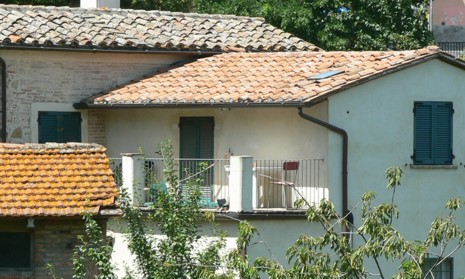
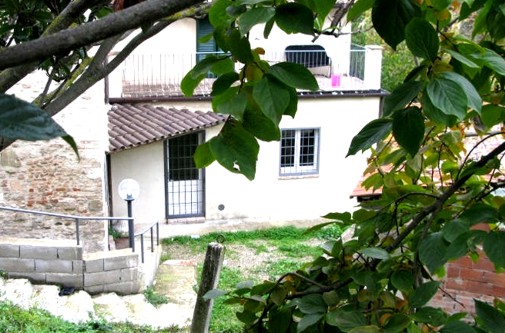
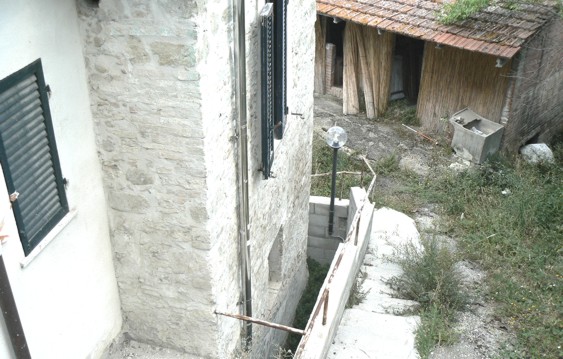
Wednesday, September 25, 2013
Why Numerous Psychologists Now Observe Knox Skeptically
Posted by SeekingUnderstanding
Links to both ITV interviews kindly provided by Clander of PMF: Daybreak Seattle interview and Daybreak London interview.
Please see the key past posts here and here and also here for some context.
Amanda Knox appeared in an English TV interview on the early morning of Monday September 23rd.
She spoke from Seattle to a detached ITV reporter in Seattle and a tough Daybreak anchor in London - tough. though she badly lacked second questions in follow-up. The interview was, by all accounts, fair, and also duly respectful towards Meredith’s family, who are in England.
But the girl or woman who is Amanda Knox we observed was neither calm nor happy.
There was not one authentic smile, and not a moment when the light came into her eyes. Her hair and make-up looked good - her presentation had been considered. But her skin was not well. As most women know, the skin, especially on the face, reveals your inner health, your inner peace.
As a psychologist, one is trained to distinguish ‘signs’, if you like, or indicators that illustrate the most crucial factors about the state of mind. One is taught to look beyond presentation and image, and too, beyond the actual words delivered, to hear what is actually being said - from the inner self or true self. Some people might prefer to use the term ‘the soul’.
What I heard in this interview is a person struggling and deeply disturbed and unhappy. I saw someone genuinely very afraid with strong feelings of hopelessness. Anger, defiance, and combativeness also showed.
But, newly, there were also signs of weariness with the self-elected fight. I believe Amanda is intelligent enough to realize that the weight and strength of the factual, combined evidence is stacked against her. Knowing this, as I believe she does, can only put her in an anguished state.
At times, one could plainly observe that a pre-rehearsed ‘PR’ line was being delivered. Amanda was being ‘a good girl’, and doing what she had been told. Examples seem to be especially where she says such things as, “I am innocent”, “my innocence has been proven”, ‘...this case is not complicated..”
Since, by applying a little elemental logic, most of these statements can be shown to be untrue, they unfortunately sounded somewhat like mantras being delivered. Rather more that these were the things AK would LIKE to believe are true. As if perhaps, if she closes her eyes often enough and wishes hard enough, they might become true…and her nightmare would now be over.
But, alas, childish unreality cannot last. We live in a world where we are required to become adults, and to act responsibly as adults.
At junctions in the interview, where some of the more penetrating questions were asked involving human relations, an ‘inner adult’ Amanda could be seen trying to emerge. One point was where she was asked about what she would do if found finally guilty.
A burgeoning sense of realism could be detected in her reply. She knows herself in this respect: she would find it unbearable to try and live as a fugitive in the free world, labeled as a murderer and a slanderer. She actually said so, with strength of feeling. It is people’s hatred of her that she can’t bear, and it is that she is protesting about so much. And indeed it must be hard to bear.
The interviewer, Lorraine, spoke at length about the Kercher family, asking AK what she would like to say to them. When Amanda replied, also at length, she said,
“... I would like them to give me a chance…”
This sounded authentic to me, I felt she meant it. However, she added to this, sounding almost like an addendum, that she wanted them to believe she could be innocent. This latter phrase, added in a different voice and intonation, didn’t ring true to my ears.
I believe that what is truly in her heart is that she longs, beyond all measure, for the Kercher family not to totally hate her. (She gives the impression that she believes they do or could hate her). She seems to truly not to be able to bear the thought of being hated, and even more unbearable, the thought that by her behaviour (as a ‘kid’) perhaps, just maybe, she might deserve that hate.
This would seem to be the source of her anguish, and also behind many other of her statements in this interview.
There would be a way through for her - a third way. This would be to start telling the truth, the whole truth, now. It is never too late to speak the truth, and it is never too early, either. The truth endures. This is a fact of history.
It would indeed take enormous courage for Amanda to take this step. It would be immensely difficult for her because of the PR campaign. But if she could begin to answer the outstanding unresolved questions, factually and honestly (unembroidered and not exaggerated), - she would, I believe, begin to heal her life, if this is genuinely what she wants.
She might be surprised at how much forgiveness there might be if she were to find the courage within herself to take this huge step. She quoted her priest/mentor from the Italian jail, when he advised her about how, at challenging times, we can find unknown resources and strength within ourselves that maybe we didn’t know we had.
She has a choice, and she could choose to do it. Making wise choices is what adults do.
Sunday, September 22, 2013
Questions For Knox: Ten Hard Questions That Knox Should Be Asked Monday On ITV’s Daybreak
Posted by The Machine
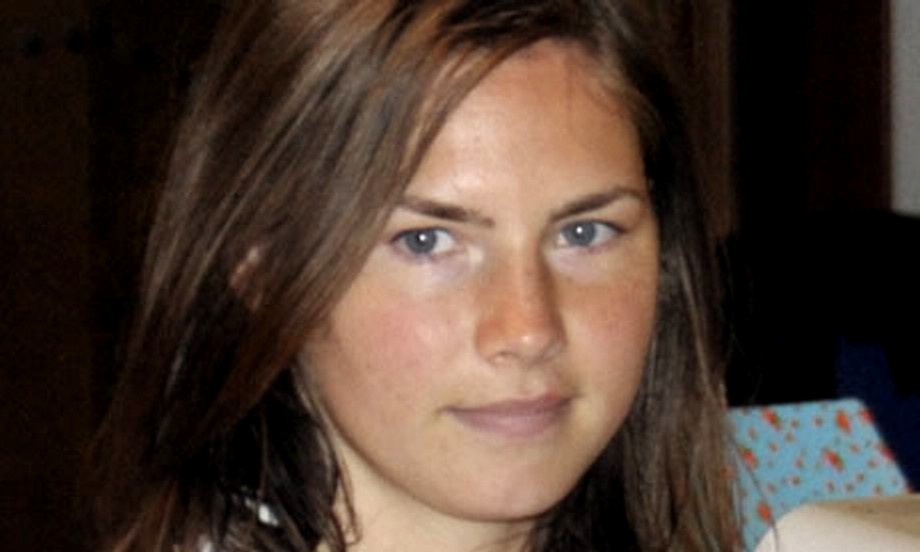
Amanda Knox will be interviewed for the first time in Britain on ITV’s Daybreak programme tomorrow.
No interviewer should unquestioningly accept everything Knox says as the gospel truth. Remember Knox served three years in prison and is labeled a convicted felon for life for malicious lying.
So let’s hope tomorrow’s interview is not yet another whiny mis-statement of the core facts, and not yet more sliming of Italian officials, of which we have just seen so many.
There are many questions on this site which Knox has never ever answered. Some arise from the evidence and some from her dishonest book.
See especially the tough questions here and here and here and here. With luck the Daybreak hosts will ask Knox all of these tough questions below.
1. Multiple false alibis
You and Raffaele Sollecito gave completely different accounts of where you were, who you were with and what you were doing on the night of the murder. Neither of you have credible alibis despite three attempts each. Sollecito told Kate Mansey from The Sunday Mirror that you and him were at a party.
He told the police that you and him were at his apartment. He then told them that he was home alone and that you weren’t at his apartment from around 9.00pm to about 1.00am. You first told the police that you were at Sollecito’s apartment. After you were informed that he was no longer providing you with an alibi, you repeatedly claimed that you went to the cottage with Diya Lumumba.
You changed your story yet again and claimed that you were at Sollecito’s apartment, but he might have gone out. All the other people who were questioned had one credible alibi that could be verified.
Extract of Sollecito’s witness statement.
“I went home, smoked a joint, and had dinner, but I don’t remember what I ate. At around eleven my father phoned me on the house phone. I remember Amanda wasn’t back yet. I surfed on the Internet for a couple of hours after my father’s phone call and I stopped only when Amanda came back, about one in the morning I think.
Question 1. Why did you and Raffaele Sollecito repeatedly tell the police and others a pack of lies?
2. False accusation
You falsely claimed that Diya Lumumba killed Meredith in two witness statements and you repeated the false accusation in your handwritten note to the police on 6 November 2007. You served three years in prison for this felony and your appeal to the Supreme Court was denied.
Question 2. Why did you repeatedly accuse Diya Lumumba of murder when you knew full well that he was completely innocent and why didn’t you or your mother retract your accusation when he was in prison?
3. The Double DNA Knife
According to a number of independent forensic experts - Dr. Patrizia Stefanoni, Dr. Renato Biondo, Professor, Giuesppe Novelli, Professor Francesca Torricelli, Luciano Garofano, Elizabeth Johnson and Greg Hampikian - Meredith’s Kercher’s DNA was found on the blade of a knife from Raffaele Sollecito’s kitchen.
He falsely claimed in his prison diary that he had accidentally pricked Meredith’s hand whilst cooking. Dr Stefanoni analysed the traces on the knife six days after last handling Meredith’s DNA. This means that contamination couldn’t have occurred in the laboratory.
Meredith had never been to Sollecito’s apartment, so contamination away from the laboratory was impossible.
Question 3. How do you think Meredith’s DNA got onto the blade of the kitchen knife?
4. The bra clasp
An abundant amount of Raffaele Sollecito’s DNA was found on Meredith’s on the exact part of Meredith bra clasp that was bent out of shape during the attack on her. His DNA was identified by two separate DNA tests. Of the 17 loci tested in the sample, Sollecito’s profile matched 17 out of 17. Professor Torricelli testified that it was unlikely the clasp was contaminated because there was a significant amount of Sollecito’s DNA on it.
Professor Novelli analysed the series of samples from all 255 items processed and found not a single instance of contamination, and ruled out as implausible that a contaminating agent could have been present just on one single result. David Balding, a Professor of Statistical Genetics at University College London, recently analysed the DNA evidence against Sollecito and concluded it was strong.
Question 4. How do you think Raffaele Sollecito’s DNA ended up on Meredith’s bra clasp?
5. The bloody footprint on the bathmat
According to two imprint experts - Rinaldi and Boemi - the bloody footprint on the blue bathmat in the bathroom matched the characteristics of Sollecito’s foot, but couldn’t possibly belong to Guede. Rudy Guede’s bloody footprints led straight out of Meredith’s room and out of the house which indicates that he didn’t go into the bathroom after Meredith had been stabbed.
See our past posts on this here and here.
Question 5. Who do you think left the bloody footprint on the bathmat?
6. Mixed samples of Amanda Knox’s DNA or blood and Meredith Kercher’s blood
According to the prosecution’s experts, there were five instances of your DNA or blood mixed with Meredith’s blood in three different locations in the cottage. Even your lawyers conceded that your blood had mingled with Meredith’s blood. In other words, Meredith and Amanda Knox were both bleeding at the same time.
Question 6. Why were you bleeding on the night of the murder and is it a coincidence that only your DNA was found mixed with Meredith’s blood?
7. The Luminol Enhanced Footprints
Bare bloody footprints were revealed by Luminol at the cottage. Three of them are compatible with your foot size and one of them is compatible with Raffaele Sollecito’s foot size.
Question 7. What do you think the Luminol was reacting to - Meredith’s blood or some other substance?
8. The staged break-in
There is absolutely no evidence that anyone stood outside Filomena’s window and climbed up the vertical wall on the night of the murder. There were no marks from soil, grass or rubber soles on the wall. The earth of the evening of 1 November 2007 was very wet, so if anybody had climbed the wall, they would have left some marks on it.
The glass on the window sill and on the floor show no signs of being touched after the window was broken, which would have been the case if the intruder had gained entry through the window.
There was not a single biological trace on any of the shards of glass. It would have been very likely that an intruder balancing on the window sill would have suffered some kind of injury or cut because of the shards of glass.
If the window had been broken from the outside, there would have been shards of glass outside, but there wasn’t even one.
Judge Massei and the panel of judges at the Italian Supreme Court specifically mentioned the shards of glass on top of Filomena’s clothes which had been tossed onto the floor in her room and regarded it as proof that the break-in was staged.
Question 8. Who do you think staged the break-in at the cottage?
9. Knowledge of the crime
Umbria Procurator General Galati’s pointed out in his appeal that you knew specific details of the crime that you could have only known if you had been present when Meredith was killed.
According to multiple witnesses at the police station, you said you were the one who had found Meredith’s body, that she was in the wardrobe, that she was covered by the quilt, that a foot was sticking out, that they had cut her throat and that there was blood everywhere. But you weren’t in a position to have seen anything at all when the door was kicked in.
In your witness statement you described Meredith’s scream. Other witnesses have corroborated your claim that there was a loud scream.
Question 9. How did you know so many precise details of the crime?
10. Shower and the “bathmat shuffle”
The Scientific Police found 13 traces of blood in the bathroom that Meredith and you shared. Prosecutor Mignini and Filomena have both expressed their surprise that you showered in a blood-spattered bathroom.
Filomena told Mignini during cross-examination: “I thought it was odd that she’d had a shower when there was blood all over the place.”
You told Mignini that you used the bathmat to shuffle to your room.
Question 10. Why did you shower in a bathroom that was splattered with blood, and did you notice the visible bloody footprint on the bathmat when you used it to shuffle to your room? And why so soon after did the police notice that you were stinking?
Lorraine Kelly and Aled Jones the ITV Daybreak hosts who should confront Amanda Knox

Wednesday, September 18, 2013
Breaking News From Italy-Based Andrea Vogt On The Aviello And Knox/Sollecito Court Actions
Posted by Peter Quennell
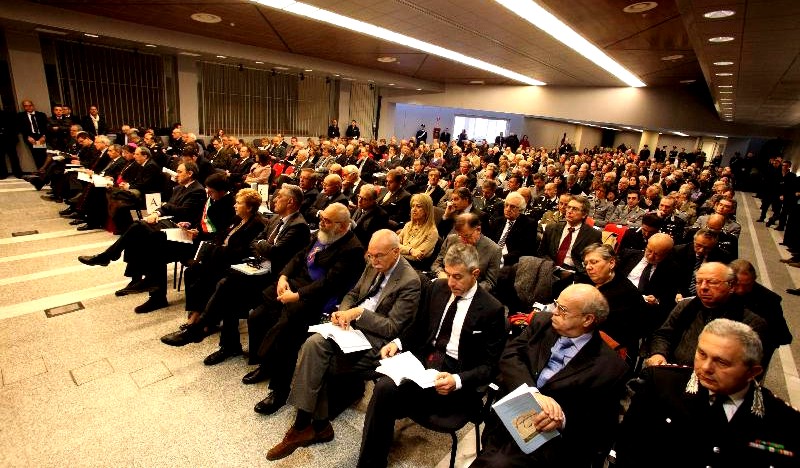
[A Florence courtroom similar in size to courtroom 32 which is assigned for the appeal]
Andrea Vogt kindly provides these details on the Knox/Sollecito appeal, the Aviello trial, and the increasingly desperate Knox and Sollecito PR.
1) Knox And Sollecito Appeal
In the first hearing on September 30, the court will decide on a fixed schedule as well whether or not to accept any defense evidence requests, such as new DNA testing or witness statements. The prosecution has also made two additional requests to the court: 1) request for another forensic review of knife to see if a small third trace that was never tested before can be examined. Experts in the first appeal deemed it low copy number and rejected requests to test it. 2) request to hear testimony from Luciano Aviello.
All our past posts on the Florence appeal can be found here and all our past posts on the DNA can be found here.
The defenses are said to have filed monsters of requests for wide scope - a virtual retrial with the defenses in prosecution mode - complete with bizarre argumentation against the rulings of Cassation. None of the defense lawyers have ever won a case before Cassation. This sure seems like a losing move as Cassation is insisting on tight focus.
2) Luciano Aviello Trial
At the heart of Aviello’s trial in Florence are likely to be the revelations by inmate Alexander Illicet from Serbia Montenegro, who testified that Aviello had agreed to pin the murder on his brother in exchange for 158,000 Euros ““ money Aviello desperately needed to pay for a sex change. Aviello himself later took back statements he made on the stand, saying he had been bribed.
The backstory to the potentially very explosive Aviello trial can be found here. If he cracks under pressure (as expected), he may spill the beans on the Sollecito family, on the defense lawyers Maori and Bongiorno. and on the judges Hellmann and Zanetti,
Potentially all could face prison. No family goes in for bribing of judges and witnesses (along with numerous other dirty tricks) if their little pride-and-joy is truly innocent.
3) Erratic Knox PR
Knox recently was featured in a number of print exclusives to the very U.K. tabloids her family blamed for sensationalizing her case at the outset. She then did her own exclusive video interview in Seattle to the same Italian columnist [used by Sollecito].
Knox, Sollecito, and Oggi are all already being investigated for contempt of court, as explained in all these past posts. For such charges, depending on the seriousness (and serial, seemingly unstoppable false accusations of crimes is pretty serious), prison sentences if found guilty might amount to ten years. That would be on top of any new sentence out of the Florence appeal which this time is likely to be 30 years.
Planet Earth to Amanda Knox: Smart move #1 could be to put aggravators David Marriott and Chris Mellas on the back burnder.
Thursday, September 05, 2013
Questions For Knox: Why So Many False Claims In Accounts Of Your Visit To The House?
Posted by James Raper
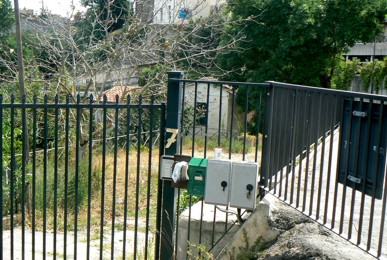
[Filomena’s shutters on approach above and below NOT half-open as they were when Knox arrived]
Additional to this post and this post on the overwhelming strength of the evidence against Sollecito and Knox.
Amanda Knox was of course lying from the start about her initial visit to the cottage to have a shower and collect a change of clothing, in the account which she gave the police when they turned up, and which she then embellished into a version of Little Red Riding Hood in her e-mail.
Here’s how we can know why. One of her most glaringly untrue claims, one not hard to fathom out and indeed I have no doubt that she had done so herself and regretted it within minutes of recounting her story to the police.
The shutters to Filomena’s window were open upon the arrival of the postal police. Massei (page 27) -
Said window had two half-closed shutters, and the right-hand shutter (the right with respect to the person looking at it) was slightly more open”› (page 62, hearing of February 6, 2009, Battistelli’s statements).
Filomena’s window is in fact the most prominent feature of the cottage for anyone walking down the lane to it. Yet, incredibly, if we are to make sense of the rest of her account, we are required to believe that Knox did not notice the shutters .
Whether they were half open or less than half open does not matter. They were open, indicating, as a matter of common sense, that the occupant of the room might be somewhere around.
You would think that anyone (anyone but Knox apparently) apprised of this elementary scrap of information about their own home and flatmates, and then in addition finding that the front door was open and no-one was answering, would have checked the other rooms, and in particular Filomena’s, out of curiosity if not concern, wouldn’t you? Of course you would.
Discovery of the broken window would then, if not before, have been inevitable, but of course in those circumstances no one would have believed that she had then had a shower and blow dried her hair.
Of course it did occur to the police that her story was a load of nonsense, just as it did to Knox and Sollecito.
See at bottom here for the famous picture of Knox and Sollecito together outside the cottage, Knox with her left hand up to her eyes and Sollecito by her side standing with his back to the window, jaws clenched and staring blankly straight ahead.
They knew, and they must have been praying hard that the police were just as stupid as them. When they were not arrested on the spot they must have thought their prayers were answered.
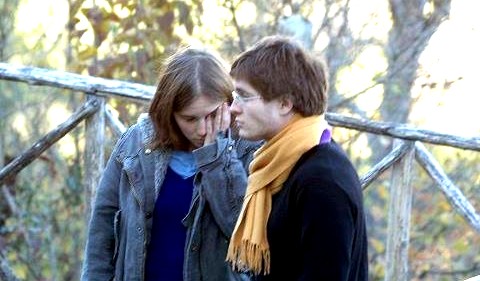
[Shower? Knox with Sollecito several hours later at which point her body odour was reported as immense]

